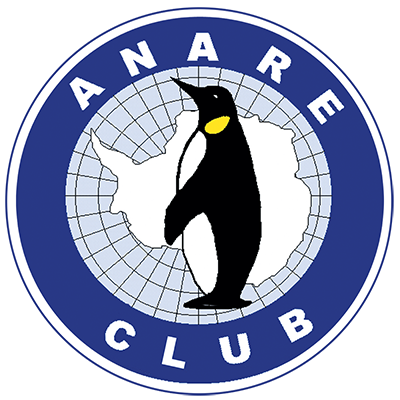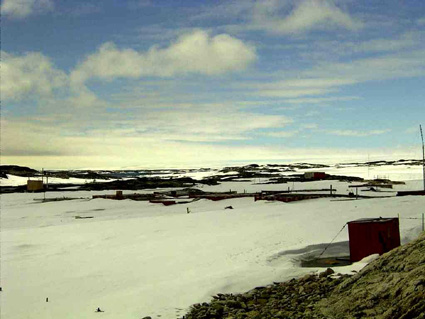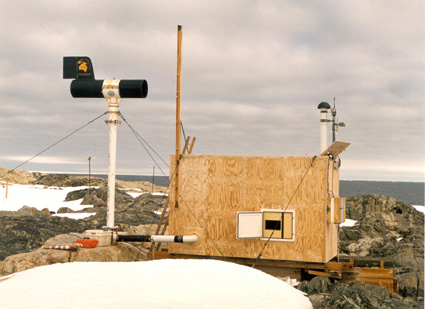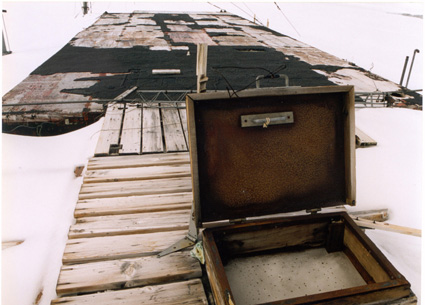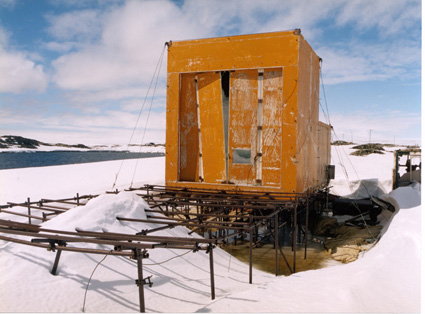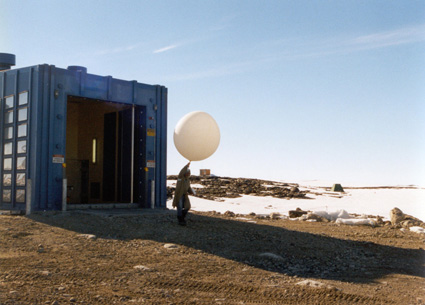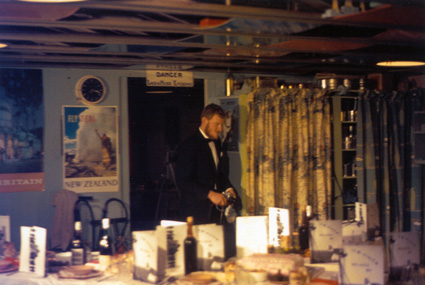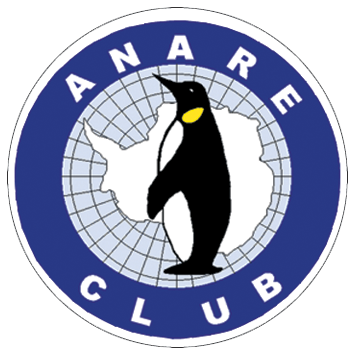Mark Forecast ANARE Club Representative VOYAGE 3, Aurora Australis, 2002 – 2003
Wilkes Revisited – After 38 years
By Mark Forecast
As I jumped from the Zodiac and clambered up the snowdrift overhang of the western tip of Clark Peninsula an eerie feeling over came me. ‘Twas the very spot from where Wally used to catch the bar chompers, those tiny cod like fish so sweet and appetizing with a home brew before the evening repast.
I had just stepped ashore into Wilkes 1965 like it was yesterday. The eerie-ness subsided to a warm and familiar ambience of the past. We ‘man-hauled’ our tiny sledge of goodies up passed the “new” balloon shed. As I recall, Torch was alleged to have burned the Yank one down in ’63. Torch was Met OiC again in ’65, wonder where he got that name? A kilometre or so on to the old radio transmitter hut, now the “Wilkes Hilton”, and all seems in order. Not much appears to have changed at all. The main station buildings are still in that reddish orange colour with their flat tar covered roofs protruding a foot or three above the snow. The balloon-shed doors are a little askew and the filling hut is half full of ice. The Auroral Tower has disappeared from the skyline and the radio mast next to the Radio/Met building has a little bit of a kink in it. All in all not too bad for an Antarctic research station constructed by the Americans over a few weeks in 1957 to serve around 24 or so scientists and maintenance people for just two years of the IGY. “Loaned” to the Australians in 1959 and totally abandoned 10 years later in ’69, Wilkes well represents a significant time in Antarctic History. Apparently three years ago the whole station was totally buried with a metre or more of drift snow above the rooftops. Now, due to good melts these past two summers, from a distance, Wilkes appears just as it did during the winter of ’65. I can hardly bear to wait until the morrow for a good reconnoitre and assurances that I’m not dreaming. Will all the buildings be filled with ice? Is there a piano in the Rec. room visible from the skylight through the ice?
What a fantastic and evocative experience this is. It came about rather abruptly when in late October I was promoted from ‘Back Up’ to ANARE Club representative on Polar Bird for V 3, the resupply and change over of Casey 2002-2003. Thanks to the expeditious organizing of the formalities by Angela Doyle and Jenny Whittaker of the AAD, the paper work was completed by December 9th and we sailed from Hobart on the evening of December 17th.
Both the weather and the seas were very kind to us and Polar Bird travelled well at about 12 knots on 75-80% power. She was well laden with supplies and quite stable in the slight to moderate seas. A Met man (again!), Bruce Alden, won the stash of cash for correctly predicting the exact time of sighting of the first iceberg, about three days out from Casey. On the 24 and 25 we encountered some light pack ice, occasionally slowing down to 4 knots in about 8 tenths pack. There was quite a lot of low cloud, fog and mist. Christmas “Dinner” commenced down in a hold with a bar-b-q including great quantities of the largest king prawns and a pig roasted on a spit. The second session was up in the crews’ mess. A superb spread including crayfish, more prawns, cold cuts, fresh fruit, cheeses, Christmas cake and pastries etc. Fortunately Christmas “night” was sunny and just after midnight we had a most magnificent sunset. A bonus for those who stayed up to see if the mist lifted was an even more fantastic sunrise about half an hour later.
During the 9-day, 2006 nautical mile voyage from Hobart to Casey we were well trained and entertained. Chief Officer Dag Hareide took us through full immersion suit and lifeboat drills. John Burgess, one of AAD’s’ field training officers was excellent with his field and safety equipment sessions. Polar B’s Master, Capt. Sigvald Brandal and his officers were great, allowing access to the bridge throughout the trip and what a top spot to observe much wild life, particularly going through pack ice. Eric Woehler, ornithologist (IASOS) was always up there and many of us enjoyed helping him and learning to identify the species of birds, seals and whales sighted. Evening talks with slides etc. were very good. These included George Blaisdell on the construction and site selection of ice/snow runways. Kim Pitt elaborated on and updated us on the Casey airfield project. Kim also spoke on the use of the Falcon 900b and Casa 212 aircraft for Australian Antarctic work. (See Aurora, June 2002). Ian Godfrey, conservator WA Museum, spoke on his ablation program with the Wilkes Sferics Hut and his work with the team on the preservation of Mawson’s Hut. Luka Vanzino showed his excellent slides of Heard Island and Big Ben belching a bit of smoke.
ANU history fellow, Tom Griffiths, presented a most enlightening oration on ‘the first women in Antarctica’. Hopefully Tom, now a member of the Club, will submit his oration for a future edition of Aurora so that we may all enjoy it
Thursday 26 December presented with a fine calm sunny morning and the mercury at 2deg. C as we approached the Windmill Islands from the Northwest. Straight toward Wilkes we went with the bow lined up on the yellow Radome, the orange balloon shed a point or two off to port. At this point Casey seemed obscured by McMullin and Shirley islands. Then we saw first the Red shed, the Green shed and the Blue powerhouse. The new Casey, is a sight to see. People were waving from the veranda of the red living quarters and mess. As Polar Bird dropped her anchor half a mile off, three Zodiacs came ‘skiing’ out across the still sunlit waters of Brown Bay. Looking ashore on this beautiful day I reflected on the many hours of three previous changeovers for Wilkes when we had labored on Cobra rock drills, helping carve out the Wharf and the foundations for REPSTAT. Replacement Station that is, the original Casey removed and RTA’d back in ‘93.
The weather remained fine and resupply and changeover took place in record time. 640 thousand litres of fuel was pumped ashore in about 24 hours. It was interesting to note in the old 1965 Wilkes station log book, August 20th, “…refueled the station, 80drums pumped into the tank farm in the morning and another 80 drums after lunch….” (That was 32000 litres). In those days all the Fuel for Wilkes was in 44-gallon drums and brought ashore by army DUKWS during the summer change over.
John Rich and his outgoing wintering party were so terrific. Even in the sometimes-hectic long hours of changeover and battling all night in the Zodiacs against cantankerous ice flows trying to disrupt the bulk fuel pumping by stretching the hose and crews to greater limits. After little or no sleep they spent much of their own time proudly showing us over Casey and all that it has to offer. It was so obvious from their high spirits, attitudes and the fine condition of the Station that all must have had an enjoyable and successful year. The catering by the Casey mess during the great invasion of troops was just tops with a 24-hour smile.
During the 5 days of changeover we all helped with packing stores away, slushy etc and were rewarded with VIP treatment and guided tours. I was very fortunate to spend several days over at Wilkes with the Western Australian Museum building preservation party and that will be the basis of my next article for the June Club Journal.
The evening of the 30th saw a change over party equal to the best. Next morning was the official change over of Casey to the new team, quite emotional with a smarting eye or two. After that fond farewell we upped anchor at 1330 and with more fine weather and slight following seas made the increased 2011 nautical miles back to Hobart in another record of just under 8 days. Good fellowship and fine sailing was enjoyed by all including New Years Eve which saw Senator Cook from WA star in the Karioki.
This episode would not be complete without sincerely thanking Dr Press and the AAD for making this opportunity for the other supernumeraries and me possible. Similarly we are very grateful to the AAD staff on the voyage and at Kingston, who all went well out of their way, sparing no effort in the midst of their busy duties to maximize all the opportunities afforded us. The hospitality and service from Captain Brandal and his Polar Bird crew was superb.
“Snowed In” photo by Mark Forecast
The weather remained fine and resupply and changeover took place in record time. 640 thousand litres of fuel was pumped ashore in about 24 hours. It was interesting to note in the old 1965 Wilkes station log book, August 20th, “…refueled the station, 80drums pumped into the tank farm in the morning and another 80 drums after lunch….” (That was 32000 litres). In those days all the Fuel for Wilkes was in 44-gallon drums and brought ashore by army DUKWS during the summer change over.
John Rich and his outgoing wintering party were so terrific. Even in the sometimes-hectic long hours of changeover and battling all night in the Zodiacs against cantankerous ice flows trying to disrupt the bulk fuel pumping by stretching the hose and crews to greater limits. After little or no sleep they spent much of their own time proudly showing us over Casey and all that it has to offer. It was so obvious from their high spirits, attitudes and the fine condition of the Station that all must have had an enjoyable and successful year. The catering by the Casey mess during the great invasion of troops was just tops with a 24-hour smile.
During the 5 days of changeover we all helped with packing stores away, slushy etc and were rewarded with VIP treatment and guided tours. I was very fortunate to spend several days over at Wilkes with the Western Australian Museum building preservation party and that will be the basis of my next article for the June Club Journal.
The evening of the 30th saw a change over party equal to the best. Next morning was the official change over of Casey to the new team, quite emotional with a smarting eye or two. After that fond farewell we upped anchor at 1330 and with more fine weather and slight following seas made the increased 2011 nautical miles back to Hobart in another record of just under 8 days. Good fellowship and fine sailing was enjoyed by all including New Years Eve which saw Senator Cook from WA star in the Karioki.
This episode would not be complete without sincerely thanking Dr Press and the AAD for making this opportunity for the other supernumeraries and me possible. Similarly we are very grateful to the AAD staff on the voyage and at Kingston, who all went well out of their way, sparing no effort in the midst of their busy duties to maximize all the opportunities afforded us. The hospitality and service from Captain Brandal and his Polar Bird crew was superb.
Sferics building boxed in and venturi for extracting moisture at Wilkes
Photo Mark Forecast
At this time in late December access to Wilkes was restricted to the sea and Zodiacs. Vehicles on the over snow route from Casey were unable to pass between the melt lakes east of the old tip site and the restricted sensitive areas of rock with their protected lichens and mosses. As resupply of Casey zoomed ahead of schedule in the sunny conditions “typical” of the Windmill Islands and the VIP planned overnight visit to the Wilkes “Hilton” was dropped, my chances of slipping over there appeared to dwindle by the hour. Three days before our departure with my change- over chores mostly completed I hung around Casey and connived all sorts of ways to achieve my goal. Many sympathetic expeditioners wanted to help, including Professor Tom Griffiths who agreed to ski over to Wilkes with me. Then, like the magic weather, it all fell into place. Dr Ian Godfrey (Western Australian Museum) and Inger Nystrom, who had been over at Wilkes since we arrived, needed to come across to Casey to do some lab work and invited me to return with them after dinner that night. At last, with some more ‘overtime’ for the already heavily taxed ’02 Casey people who manned the Zodiacs and the blessing of their Station Leader, my great adventure slipped into overdrive.
Awaking at 0500 hrs after a very comfortable night in my bunk at the Wilkes “Hilton” I popped a small log into the pot-belly and put on my outdoor gear. Not wishing to disturb my hosts from the WA Museum Materials Conservation team, I grabbed an ice axe (in lieu of the “sharp ANARE”) and a block of ‘Cadbury’ Old Jamaica and slipped quietly out to begin my reconnoitre of good old Wilkes. I headed east toward the plateau and moraines. It was a sunny still morning and by the way the snow crunched underfoot, I guestimated the temperature at minus 3 or 4 degrees C. Down past the dog lines I could almost hear Lacka & Nookie’s welcoming yaps as they eagerly awaited their morning pats. Perhaps a harness up and a quick dash out on the sea ice for a seal to supplement their pemmican rations? Alas, it all fades as I dawdle through the old tip site with the rusting drums and empty ammonia bottles, marked US Navy, protruding through the snow and ice. There’s the skeleton of a Weasel up on some rocks. I ponder the age-old question again, Weasels or Huskies? Well Weasels were not much chop amongst the slots over at the Vanderford Glacier when measuring those moving bamboo canes. An infamous quote from I remember not where, ” … One needs not feed the Weasel when one’s held up in a blizz, nor can one eat it”.
Up on the rocky outcrops away from the tip to the north there still rests the remains of a big cat tractor or bulldozer, which has been pirated for parts many times over. Numerous boxes of spares inherited from the Americans now lie broken and rusted, after decades of exposure to the harsh conditions.
Back toward Wilkes, high on a hill dominating the early morning skyline, two crosses mark the graves of two past ANARE men. I decide to climb up and pay my respects. The two sturdy Oregon crosses above the piled rock graves are well weathered on the windward sides from perpetual snow blasting over the years. Interestingly the lower third of the crosses is in much better condition, indicating snow accumulation up to this level for much of the time. R.I.P., Hartley Robinson (1959) and Reginald Sullivan (1968). The view from up here beside the graves is superb. The low summer sun seems to highlight all things in all directions. To the north numerous gigantic icebergs refract to greater heights along the Pedersen Bank, while Jack’s Donga, a little bigger than the original tractor cab of ’65, shines brightly atop the Moraine. The glare off the plateau toward Law dome is breathtaking and the “Tit”, named for its obvious topography, stands out as ever the landmark in a bright pink ‘sunrise’ glow. Shadows of well-marked vehicle tracks also stand out in the snow and ice. >From Casey to the Wilkes melt pools and Lanyon’s Junction back down to Casey the tracks form a highway. To the south Casey is now a hive of activity with the barges back-loading RTA goodies to the Polar Bird. Time to head back to the Hilton and a cup of coffee. I can see Ian and Inger working up on the roof of the Sferics hut. [ Sferics was the colloquial term for atmospheric disturbances, or lightening strikes that were plotted by three stations Wilkes, Perth and Melbourne simultaneously, via a radio voice link, to try and monitor storm fronts approaching Australia from the Southern Ocean Ed.]
Approaching Wilkes from both the old dog lines or from the sea (Wally Demech’s fishing spot), the Station looked very similar to how it looked in winter when I was last here those many years ago. Snow drifts almost up to the rooftops with a bit of wind scouring exposing the upper walls. It is only when one gets up close that the marked deterioration is so sadly obvious.
Many of the double glazed skylights are cracked and broken, probably from distortion as roof panels are pushed and shoved by movement of the ice inside. Some damage may be the result of “missiles” flung in the many blizzards over the past thirty years since regular maintenance ceased. The vestibule or cold porch entrance to the recreation building has been pushed a foot away from the reckie-
Ice up to the roof inside the old Met./Radio building
Photo Mark Forecast.
room adjoining wall as has the wall itself, by ice inside the building. Solid white ice appears to totally fill the entire main building complex with no visibility penetration at all down through the skylights. There is a hatch in the Met. office corridor roof from where we observers used to pop up every three hours to assess the weather conditions and read the instruments in the roof-mounted Stevenson screen. On lifting the hatch, again solid opaque ice right up to the top. Of course the screen and all the instruments were removed shortly after Casey commenced operations, as was most of the equipment from inside. There is no possibility of entry to any of the main building complex, powerhouse or mechanical workshop. Up on rock outcrops beside the workshop there are the remains of some of the black rubber, fuel storage bladders. The scaffold-supported platforms are still intact. The old yellow fibreglass Radome on top of the rocks west of the fuel farm is still in very good condition and free of drift. With the dome now empty, the acoustics inside are quite something and it is occasionally used as a sleep over by visitors from Casey. I guess the Wilkes “Hilton” with its superior amenities would have to be really well over-booked for any demand on the “Met”, arias or not.
From up here beside the Radome is also a great view. As I sit a while in the warm sun staring south across Newcomb Bay to Casey and reminiscing, it all comes flooding back. What super times, belting across the sea ice to deliver fresh bread to Gibbo (Peter Gibson) and his crew of volunteers working on the first building for Repstat, the “Tunnel” as mentioned earlier, now demolished and RTA. My transport then was a BSA Bantam motorcycle, belonging to Scruffie (Ken Shennan) and Hooby (Tony Warriner). On one such milk run there suddenly appeared a tide crack, hidden by light snow and wider than the bike. It swallowed us up. There I was half way to Repstat, after flying over the handlebars, lying on the ice on the far side of the gap, hanging on to the submerged Bantam with one hand and waving frantically to two guys on the roof at Repstat with the other arm. They did not see me, so after an eternity I let the Bike go and walked back to Wilkes to report my indiscretion to the owners, who incidentally had up till then, not had a chance to ride their own machine. What was I to say? I had to spend the rest of the year with these guys after tossing away their favourite toy. Well, so typical of Scruffie and Hooby, …”you OK? …So you gave her swimming lessons and she failed! Seeya at the bar at five.” As I stare across I reckon I can pin point the spot and wonder if perhaps John Runci who is down with the AAD Bio dive team might pop down and attach a line.
Suddenly something caused me to look back from my vantage point over Wilkes. There were several red-suited persons wandering about the Hilton and several more wandering up from the direction of the old dog lines. The VIPs had landed way up past the rubbish dump, somewhat further away but at a much easier landing spot to step ashore. I popped down, meeting them at the balloon shed and enjoyed helping to show them around.
Old balloon-filling building at Wilkes
Photo Mark Forecast
At Wilkes we employed a unique piece of equipment inherited from the Americans to produce hydrogen for filling the Met. balloons. It was a “Baker Hydroneal Retort” which at fairly high temperature broke ammonia down to nitrogen and hydrogen. The hydrogen was bled off at preset amounts and directly fed across to the inflating or filling shed straight into the balloon. As I recall the retort developed some horrible cracks and at one stage it looked like reverting to the nasty Shaky-shaky bottle system using caustic soda and ferrous silicate to make hydrogen. Gibbo to the rescue again. Without the correct welding rods but with plenty of ingenuity and skill Peter effected a satisfactory repair which lasted the rest of the year. We did have a limited supply of commercial bottled hydrogen for emergencies, about one week’s worth in all. Nowadays Australian Antarctic stations and some remote mainland stations have “electrolyser” hydrogen generators. Basically this equipment passes electricity through purified water which has potassium hydroxide added as an electrolyte. The water is broken down into the hydrogen and oxygen from which it is formed. The hydrogen is bled off and stored in low-pressure tanks to be used as required, but the oxygen is wasted off to the atmosphere.
After a few hours the VIPs return to their waiting Zodiacs. I am privileged to accompany Professor Geoff Stevens, head of Chemical Engineering at Melbourne University and Dr Martin Riddle from AAD as they examine junk around the outskirts of Wilkes and at the old tip site. It’s pleasing to note that their charter is to examine the situation and input to a future plan to clean up these sites and RTA all the junk and old redundant equipment. Perhaps this ‘plan’ will include the Law Dome drill site. I did not think to ask at the time, but they had best be quick if it does as snow accumulation can be several metres per year in that area.
The visitors take off for Casey – without me. Looks like I must impose further on Ian and Inger’s generous hospitality. They put me to work assisting with the tidying up and preparing the Sferics hut for another year on its own. Some six years ago this experiment of building restoration and conservation was commenced. The hut stands separately to the north of the main Wilkes buildings on a platform on a rocky outcrop. It is about 15 feet by 8 feet and about eight feet high. At the start of the experiment the hut was sealed up completely, by total re-cladding, to stop further invasion of ice, melt and drift snow. Access is by sealed hatches, one in the roof and one in a side wall. A flow through of air is used to remove snow and ice from the interior of the building and to reduce the deterioration of internal structures, fittings and objects. A venturi ventilation system draws snow-free air through the building, concurrently removing water vapour and lowering the relative humidity in the building.
Launching an early morning balloon from the new Casey balloon-filling shed
Photo Mark Forecast
We knock off at about 2300 hrs (yes 11pm) and enjoy a G&T with blue plateau ice, sitting outside the Hilton in the sun on this lovely still evening. Inger kindly cooks up some steaks and vegies. This is the last night at Wilkes for all of us and Inger produces a bottle of Jul Glögg, Swedish mulled wine brought all the way from Sweden for this auspicious occasion.
Early rise next day, December 30th. Ian and Inger still have quite a bit of work to finish up at the Sferics hut. My job is to tidy up the Hilton and collect all the rubbish. Everything including all human waste, urine, wash up water etc has to be parcelled and bottled up and taken back to Casey for disposal. Shortly after midday the three Zodiacs arrive to pick us up for our return to Casey. They have brought a pleasant surprise in that all the other round trippers who had not yet been to Wilkes are accompanying them. As they look around they jump in and help lug all our gear from the Hilton, the kilometre or so back to the Zodiac embarkation point. And so we bid a fond farewell to Wilkes from Walter’s favourite fishing spot.
Back at Casey for a shower and the greatest of changeover parties. It was well crowded with two crews, a large summer party and heaps of round trippers. Much later I found a quiet spot in the field store and retired to a cosy sleeping bag. Up at 0630 to film a balloon released by the esteemed Peter Johnson shown in the picture. He who then downloaded my digital camera pictures to disk for me.
1330 hrs December 31st Bon voyage, Toodaloo Casey.
By an appreciative Mark Forecast.
Ghost of Wilkes past. Mark Forecast midwinter 1965
Photo Ken Shennan
For the top team of 1965 Wilkes blokes.
